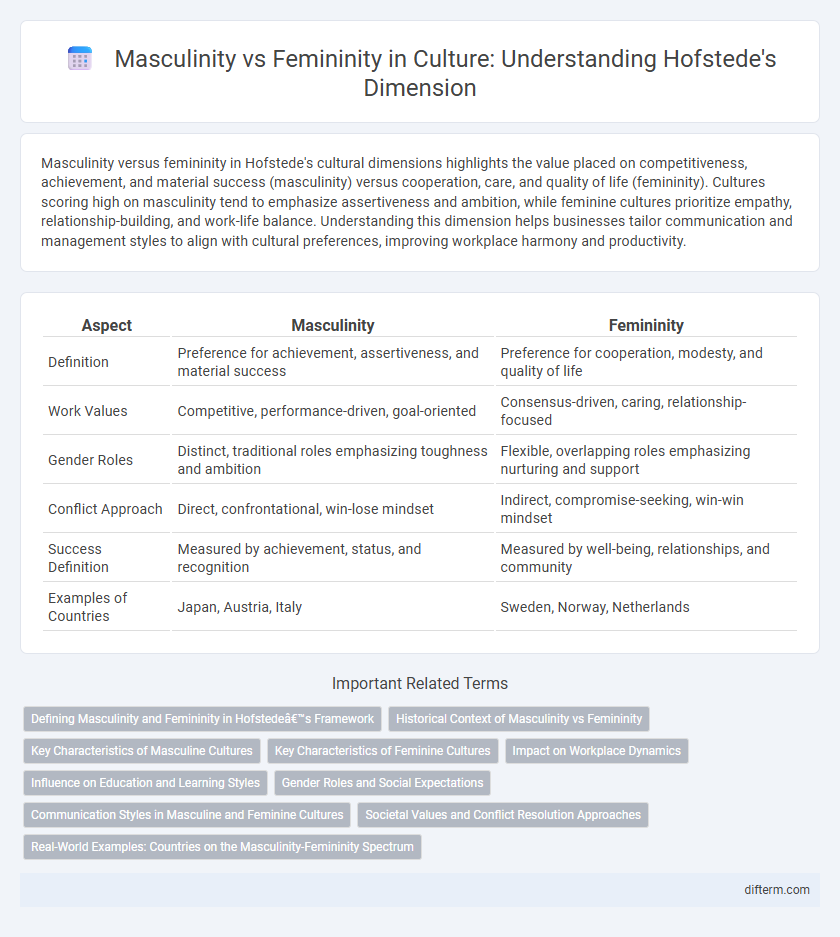Masculinity versus femininity in Hofstede's cultural dimensions highlights the value placed on competitiveness, achievement, and material success (masculinity) versus cooperation, care, and quality of life (femininity). Cultures scoring high on masculinity tend to emphasize assertiveness and ambition, while feminine cultures prioritize empathy, relationship-building, and work-life balance. Understanding this dimension helps businesses tailor communication and management styles to align with cultural preferences, improving workplace harmony and productivity.
Table of Comparison
| Aspect | Masculinity | Femininity |
|---|---|---|
| Definition | Preference for achievement, assertiveness, and material success | Preference for cooperation, modesty, and quality of life |
| Work Values | Competitive, performance-driven, goal-oriented | Consensus-driven, caring, relationship-focused |
| Gender Roles | Distinct, traditional roles emphasizing toughness and ambition | Flexible, overlapping roles emphasizing nurturing and support |
| Conflict Approach | Direct, confrontational, win-lose mindset | Indirect, compromise-seeking, win-win mindset |
| Success Definition | Measured by achievement, status, and recognition | Measured by well-being, relationships, and community |
| Examples of Countries | Japan, Austria, Italy | Sweden, Norway, Netherlands |
Defining Masculinity and Femininity in Hofstede’s Framework
Hofstede's framework defines masculinity as a cultural preference for achievement, heroism, assertiveness, and material success, while femininity emphasizes cooperation, modesty, caring for the weak, and quality of life. Masculine societies value competitiveness and ambition, often prioritizing career advancement and financial rewards. Feminine societies prioritize work-life balance, interpersonal relationships, and social support, reflecting an orientation toward nurturing and collective well-being.
Historical Context of Masculinity vs Femininity
Hofstede's cultural dimension of masculinity versus femininity reflects deep-rooted historical trends where masculine cultures emphasize competition, achievement, and material success, often shaped by industrialization and wartime valorization of assertiveness and heroism. Feminine cultures historically prioritize cooperation, care, and quality of life, reflecting agrarian societies and communal living that valued nurturing and social cohesion. These historical contexts influenced societal roles, workplace dynamics, and gender expectations, underpinning modern cultural attitudes toward gender identity and social behavior.
Key Characteristics of Masculine Cultures
Masculine cultures, according to Hofstede's dimensions, emphasize achievement, assertiveness, and material success as key values, prioritizing competition and ambition. These societies typically encourage distinct gender roles, with men expected to be strong providers and women more focused on nurturing and quality of life. Work and performance are central, often valuing toughness and a high degree of challenge in professional and social environments.
Key Characteristics of Feminine Cultures
Feminine cultures, according to Hofstede's dimensions, prioritize values such as care, collaboration, and quality of life over assertiveness and competition. These societies emphasize gender equality, interpersonal relationships, and emotional expressiveness, fostering environments where empathy and consensus-building are crucial. Examples include Scandinavian countries like Sweden and Norway, where social support systems and work-life balance are highly valued.
Impact on Workplace Dynamics
Masculinity versus femininity, as defined by Hofstede's cultural dimensions, significantly influences workplace dynamics by shaping communication styles, leadership approaches, and conflict resolution. Masculine cultures prioritize achievement, competitiveness, and assertiveness, promoting a results-driven and hierarchical work environment. Feminine cultures emphasize collaboration, empathy, and work-life balance, fostering inclusive, supportive, and flexible organizational practices.
Influence on Education and Learning Styles
Masculinity versus femininity in Hofstede's cultural dimensions significantly impacts education and learning styles by shaping classroom dynamics and teacher-student interactions; masculine cultures often emphasize competitiveness, achievement, and task-oriented learning, whereas feminine cultures prioritize cooperation, care, and relationship-oriented approaches. In masculine societies, students are encouraged to excel through performance-driven assessments and individual recognition, while feminine cultures favor collaborative projects and group harmony that nurture social skills alongside academic development. These cultural orientations influence curriculum design, teaching methods, and evaluation criteria, ultimately affecting student motivation and educational outcomes worldwide.
Gender Roles and Social Expectations
Masculinity vs. femininity in Hofstede's cultural dimensions highlights distinct gender roles, where masculine societies emphasize competitiveness, assertiveness, and material success, often associating men with leadership and women with nurturing roles. Feminine cultures prioritize cooperation, care, and quality of life, promoting gender equality and flexible social expectations for both men and women. These cultural norms profoundly influence workplace behavior, family dynamics, and social policies within different societies.
Communication Styles in Masculine and Feminine Cultures
Masculine cultures emphasize direct, assertive communication, valuing clarity and competitiveness, while feminine cultures prioritize empathetic, nurturing dialogues that foster collaboration and harmony. In masculine societies, communication often involves straightforward expressions of opinions and a focus on results, contrasting with feminine societies where indirect communication and active listening prevail to maintain relationships. Understanding these distinctions enhances intercultural interactions by aligning communication strategies with culturally embedded expressions of masculinity and femininity.
Societal Values and Conflict Resolution Approaches
Masculinity in Hofstede's cultural dimensions emphasizes assertiveness, competitiveness, and achievement, shaping societal values that prioritize ambition and success over relationships. Femininity values cooperation, care, and quality of life, fostering social harmony and collective well-being in conflict resolution. Cultures with masculine traits tend to approach conflicts through direct confrontation and clear winners, while feminine cultures favor negotiation, compromise, and preserving interpersonal relationships.
Real-World Examples: Countries on the Masculinity-Femininity Spectrum
Japan ranks high on Hofstede's masculinity scale, emphasizing competition, achievement, and material success, while Sweden scores low, highlighting quality of life, caring for others, and cooperation as key societal values. Germany also exhibits strong masculine traits through its focus on performance and success, in contrast to the Netherlands, where egalitarianism and work-life balance align with feminine cultural dimensions. These real-world examples showcase how Hofstede's masculinity-femininity spectrum influences social behaviors and workplace norms across countries.
masculinity vs femininity (Hofstede) Infographic

 difterm.com
difterm.com